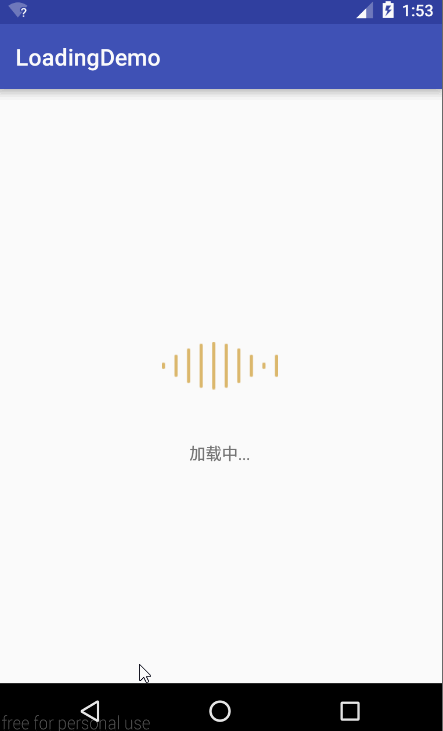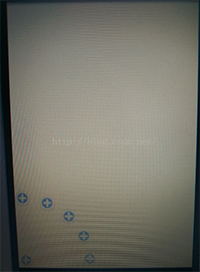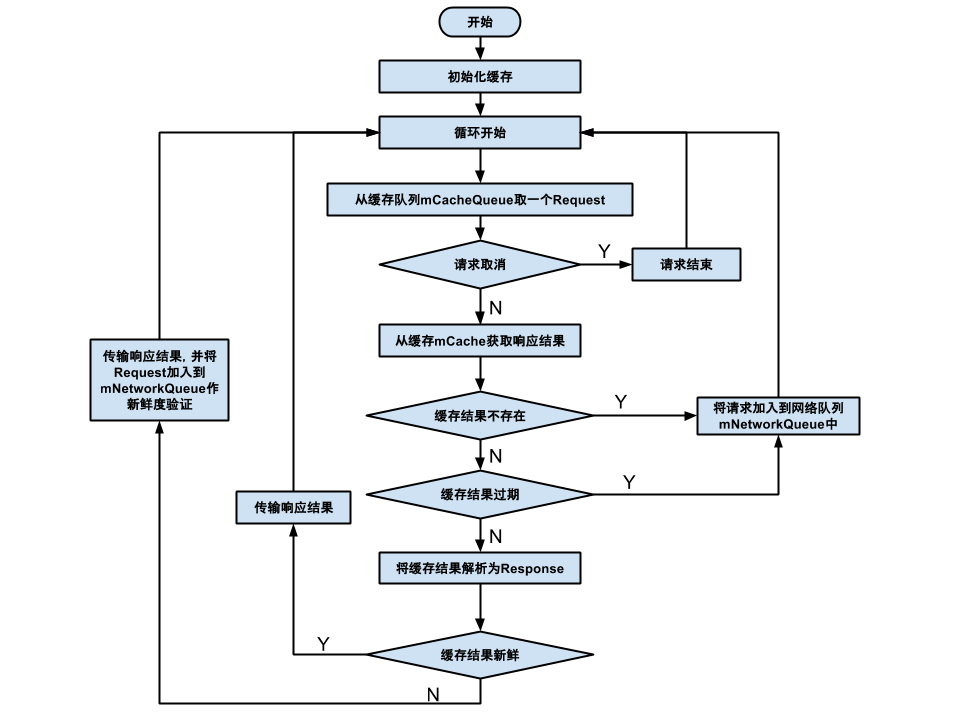編輯:關於Android編程
在設計應用的時候,我們應該熱愛極簡主義,簡單就是好的,對於很多用戶來說,復雜的東西並不受歡迎。
我要實現的是根據不同的情況去顯示不同的加載效果,隨用隨調,效果是借鑒於某一項目的效果,我認為有必要提取出來改善封裝一下,供以後使用。情況大致分為:加載中、無網絡、無數據、加載失敗等,這些僅僅就需要一個View 就可以搞定啦!
預覽下效果圖:

我們怎麼實現這種效果呢
view_loading.xml的布局如下:
<?xml version="1.0" encoding="utf-8"?> <FrameLayout xmlns:android="http://schemas.android.com/apk/res/android" android:layout_width="match_parent" android:layout_height="match_parent"> <LinearLayout android:id="@+id/lin_loading" android:layout_width="wrap_content" android:layout_height="wrap_content" android:layout_gravity="center" android:visibility="gone" android:orientation="vertical"> <ImageView android:id="@+id/img_loading" android:layout_width="100dp" android:layout_height="100dp" android:src="@drawable/loading_animation" /> <TextView android:id="@+id/tv_loading" android:layout_width="wrap_content" android:layout_height="wrap_content" android:layout_marginTop="16dp" android:layout_gravity="center_horizontal" android:textSize="14sp" /> </LinearLayout> <LinearLayout android:id="@+id/lin_load" android:layout_width="wrap_content" android:layout_height="wrap_content" android:layout_gravity="center" android:gravity="center" android:orientation="vertical" android:visibility="visible" > <ImageView android:id="@+id/iv_load" android:layout_width="100dp" android:layout_height="100dp" android:src="@mipmap/ic_launcher" /> <TextView android:id="@+id/tv_load" android:layout_width="wrap_content" android:layout_gravity="center_horizontal" android:layout_height="wrap_content" /> <Button android:id="@+id/btn_load" android:layout_width="wrap_content" android:layout_height="wrap_content" android:layout_marginTop="8dp" android:layout_gravity="center_horizontal" android:textSize="14sp" /> </LinearLayout> </FrameLayout>
從布局來看,我分了兩個部分,一個是加載中,另外一個是帶有ImagView、文字和按鈕的布局,有人看到這,就會說,哇靠,這不是很簡單嗎?根據不同的情況去設置Visibility的值就好了啊,沒錯,原理就是這樣。
XHLoadingView.java的代碼如下:
package com.woyou.loadingdemo.widget;
import android.content.Context;
import android.graphics.drawable.AnimationDrawable;
import android.util.AttributeSet;
import android.view.LayoutInflater;
import android.view.View;
import android.widget.Button;
import android.widget.FrameLayout;
import android.widget.ImageView;
import android.widget.LinearLayout;
import android.widget.TextView;
import com.woyou.loadingdemo.LoadingState;
import com.woyou.loadingdemo.R;
/**
* Created by Xiho on 11:21.
*/
public class XHLoadingView extends FrameLayout {
private Context mContext;
// 加載中的布局
private LinearLayout mLinearLoad;
//其他加載的布局
private LinearLayout mLinearLoading;
private TextView mTvLoading;
private TextView mTvLoad;
private ImageView mIvLoading;
private ImageView mIvLoad;
private Button mBtnLoad;
private LoadingState mState;
private AnimationDrawable animation;
public XHLoadingView(Context context) {
super(context);
mContext = context;
}
public XHLoadingView(Context context, AttributeSet attrs) {
super(context, attrs);
mContext = context;
}
public XHLoadingView(Context context, AttributeSet attrs, int defStyleAttr) {
super(context, attrs, defStyleAttr);
mContext = context;
}
public XHLoadingView(Context context, AttributeSet attrs, int defStyleAttr, int defStyleRes) {
super(context, attrs, defStyleAttr, defStyleRes);
mContext = context;
}
public void build(){
LayoutInflater.from(mContext).inflate(R.layout.view_loading, this, true);
mLinearLoading = (LinearLayout) findViewById(R.id.lin_loading);
mLinearLoad = (LinearLayout) findViewById(R.id.lin_load);
mIvLoading = (ImageView) findViewById(R.id.img_loading);
mIvLoad = (ImageView) findViewById(R.id.iv_load);
mTvLoading = (TextView) findViewById(R.id.tv_loading);
mTvLoad = (TextView) findViewById(R.id.tv_load);
mBtnLoad = (Button) findViewById(R.id.btn_load);
mBtnLoad.setOnClickListener(new OnClickListener() {
@Override
public void onClick(View v) {
setState(LoadingState.STATE_LOADING);
mOnRetryListener.onRetry();
}
});
}
@Override
public void setVisibility(int visibility) {
super.setVisibility(visibility);
if(View.GONE==visibility && mState==LoadingState.STATE_LOADING && animation!=null&&animation.isRunning()){
animation.stop();
}
}
/**
* 加載中提示文字
*/
private String mLoadingText;
private int mLoadingIcon;
public XHLoadingView withLoadingIcon(int resId){
mLoadingIcon = resId;
return this;
}
/**
* 加載數據為空提示文字
*/
private String mLoadEmptyText;
private int mLoadEmptyIcon;
public XHLoadingView withEmptyIcon(int resId){
mLoadEmptyIcon = resId;
return this;
}
/**
* 無網絡提示
*/
private String mLoadNoNetworkText;
private int mNoNetworkIcon;
public XHLoadingView withNoNetIcon(int resId){
mNoNetworkIcon = resId;
return this;
}
private OnRetryListener mOnRetryListener;
/**
* 定義重試的的接口
*/
public interface OnRetryListener {
void onRetry();
}
public XHLoadingView withOnRetryListener(OnRetryListener mOnRetryListener){
this.mOnRetryListener = mOnRetryListener;
return this;
}
/**
* 設置加載的狀態
* @param state
*/
public void setState(LoadingState state){
if(mState==state){
return;
}else if(state==LoadingState.STATE_LOADING){
mLinearLoading.setVisibility(VISIBLE);
mLinearLoad.setVisibility(GONE);
}else if(state!=LoadingState.STATE_LOADING){
mLinearLoading.setVisibility(GONE);
mLinearLoad.setVisibility(VISIBLE);
if(animation!=null && mState==LoadingState.STATE_LOADING)
animation.stop();
}
changeState(state);
}
public boolean btnEmptyEnable = true;
public boolean btnErrorEnable = true;
public boolean btnNoNetworkEnable = true;
public XHLoadingView withBtnNoNetEnnable(boolean ennable) {
btnNoNetworkEnable = ennable;
return this;
}
public XHLoadingView withBtnErrorEnnable(boolean ennable) {
btnErrorEnable = ennable;
return this;
}
public XHLoadingView withBtnEmptyEnnable(boolean ennable) {
btnEmptyEnable = ennable;
return this;
}
/**
* 改變狀態
* @param state
*/
private void changeState(LoadingState state) {
switch (state) {
//加載中
case STATE_LOADING:
mState = LoadingState.STATE_LOADING;
mIvLoading.setImageResource(mLoadingIcon);
mTvLoading.setText(mLoadingText);
if (animation == null) {
animation = (AnimationDrawable) mIvLoading.getDrawable();
}
if (animation != null)
animation.start();
break;
//數據為空
case STATE_EMPTY:
mState = LoadingState.STATE_EMPTY;
mIvLoad.setImageResource(mLoadEmptyIcon);
mTvLoad.setText(mLoadEmptyText);
if (btnEmptyEnable) {
mBtnLoad.setVisibility(VISIBLE);
mBtnLoad.setText(btn_empty_text);
} else {
mBtnLoad.setVisibility(GONE);
}
break;
//加載失敗
case STATE_ERROR:
mState = LoadingState.STATE_ERROR;
mIvLoad.setImageResource(mErrorIco);
mTvLoad.setText(mLoadErrorText);
if (btnErrorEnable) {
mBtnLoad.setVisibility(VISIBLE);
mBtnLoad.setText(btn_error_text);
} else {
mBtnLoad.setVisibility(GONE);
}
break;
//無網絡
case STATE_NO_NET:
mState = LoadingState.STATE_NO_NET;
mIvLoad.setImageResource(mNoNetworkIcon);
mTvLoad.setText(mLoadNoNetworkText);
if (btnNoNetworkEnable) {
mBtnLoad.setVisibility(VISIBLE);
mBtnLoad.setText(btn_nonet_text);
} else {
mBtnLoad.setVisibility(GONE);
}
break;
}
}
/**
* 後台或者本地出現錯誤提示
*/
private String mLoadErrorText;
private int mErrorIco;
public XHLoadingView withErrorIco(int resId) {
mErrorIco = resId;
return this;
}
/**
* 加載空數據
* @param resId
* @return
*/
public XHLoadingView withLoadEmptyText(int resId) {
mLoadEmptyText = getResources().getString(resId);
return this;
}
public XHLoadingView withLoadEmptyText(String mLoadEmptyText) {
this.mLoadEmptyText = mLoadEmptyText;
return this;
}
/**
* 無網絡時候加載文字
* @param resId
* @return
*/
public XHLoadingView withLoadNoNetworkText(int resId) {
mLoadNoNetworkText = getResources().getString(resId);
return this;
}
public String btn_empty_text = "重試";
public String btn_error_text = "重試";
public String btn_nonet_text = "重試";
/**
* 數據為空的Button的文字提示
* @param text
* @return
*/
public XHLoadingView withBtnEmptyText(String text) {
this.btn_empty_text = text;
return this;
}
/**
* 加載錯誤的Button的文字提示
* @param text
* @return
*/
public XHLoadingView withBtnErrorText(String text) {
this.btn_error_text = text;
return this;
}
/**
* 加載錯誤的文字提示
* @param resId
* @return
*/
public XHLoadingView withLoadErrorText(int resId) {
this.mLoadErrorText = getResources().getString(resId);
return this;
}
public XHLoadingView withLoadErrorText(String mLoadedErrorText) {
this.mLoadErrorText = mLoadedErrorText;
return this;
}
/**
* 加載無網絡的Button的文字提示
* @param text
* @return
*/
public XHLoadingView withBtnNoNetText(String text) {
this.btn_nonet_text = text;
return this;
}
/**
* 加載沒有網路的文字提示
* @param mLoadedNoNetText
* @return
*/
public XHLoadingView withLoadNoNetworkText(String mLoadedNoNetText) {
this.mLoadNoNetworkText = mLoadedNoNetText;
return this;
}
public XHLoadingView withLoadingText(int resId) {
this.mLoadingText = getResources().getString(resId);
return this;
}
public XHLoadingView withLoadingText(String mLoadingText) {
this.mLoadingText = mLoadingText;
return this;
}
}
針對不同的情況作了不同的處理,然後我們在需要的Activity調用。
private XHLoadingView mLoadingView;
@Override
protected void onCreate(Bundle savedInstanceState) {
super.onCreate(savedInstanceState);
setContentView(R.layout.activity_display);
mLoadingView = (XHLoadingView) findViewById(R.id.lv_loading);
mLoadingView.withLoadEmptyText("≥﹏≤ , 啥也木有 !").withEmptyIcon(R.drawable.disk_file_no_data).withBtnEmptyEnnable(false)
.withErrorIco(R.drawable.ic_chat_empty).withLoadErrorText("(῀( ˙᷄ỏ˙᷅ )῀)ᵒᵐᵍᵎᵎᵎ,我家程序猿跑路了 !").withBtnErrorText("臭狗屎!!!")
.withLoadNoNetworkText("你擋著信號啦o( ̄ヘ ̄o)☞ᗒᗒ 你走").withNoNetIcon(R.drawable.ic_chat_empty).withBtnNoNetText("網弄好了,重試")
.withLoadingIcon(R.drawable.loading_animation).withLoadingText("加載中...").withOnRetryListener(new XHLoadingView.OnRetryListener() {
@Override
public void onRetry() {
SnackbarUtil.show(mLoadingView,"已經在努力重試了",0);
}
}).build();
}
........
//加載中
mLoadingView.setVisibility(View.VISIBLE);
mLoadingView.setState(LoadingState.STATE_LOADING);
//空數據
mLoadingView.setVisibility(View.VISIBLE);
mLoadingView.setState(LoadingState.STATE_EMPTY)
//無網絡
mLoadingView.setVisibility(View.VISIBLE);
mLoadingView.setState(LoadingState.STATE_NO_NET);
//加載錯誤
mLoadingView.setVisibility(View.VISIBLE);
mLoadingView.setState(LoadingState.STATE_ERROR);
.......
}
上面我是為了展示不同的效果,所以寫了幾個點擊事件呢,實際中不是這樣的,初始化過後,在需要的地方調用OK, 源碼中注釋詳細,就不用再做過多的解釋了吧!
完整代碼:XHLoadingView
作者:xuhao
QQ:504105930
轉載請注明出處:http://blog.csdn.net/u011974987/article/details/51455333
以上就是本文的全部內容,希望對大家學習Android軟件編程有所幫助。
 android_文件下載
android_文件下載
android 在網絡上下載文件步驟 : 1.使用HTTP協議下載文件- 創建一個HttpURLConnection對象 : HttpURLConnection urlC
 Android自定義VIew實現衛星菜單效果淺析
Android自定義VIew實現衛星菜單效果淺析
一 概述:最近一直致力於Android自定義VIew的學習,主要在看《android群英傳》,還有CSDN博客鴻洋大神和wing大神的一些文章,寫的很詳細,自
 android - Volley源碼分析
android - Volley源碼分析
我有一篇文章很不負責的,沒有頭緒的分析了一些Volley的源碼。我自己回頭去看了一下,於是就把他刪掉了,於是就有了今天的這篇文章。Volley的使用步驟創建一個Reque
 fastlane 教程: 入門
fastlane 教程: 入門
激動人心的時刻到來了:你花了幾天和幾周時間(甚至是幾個月)制作了一個精彩的 App,准備發布到全世界。剩下來的事情就是將 App 提交到蘋果商店了,但是 —&